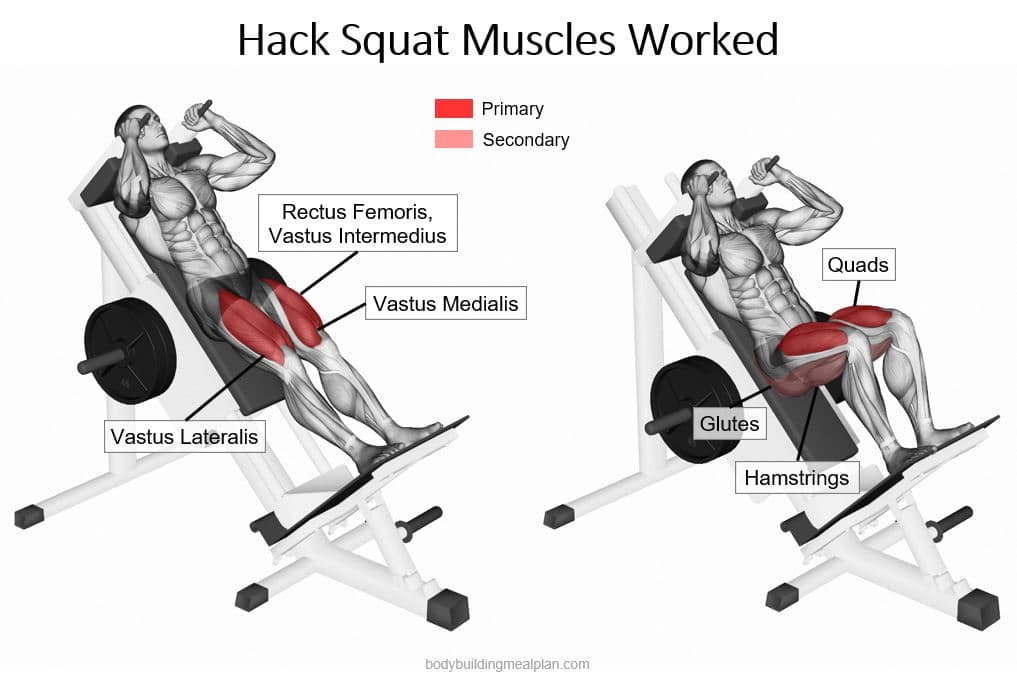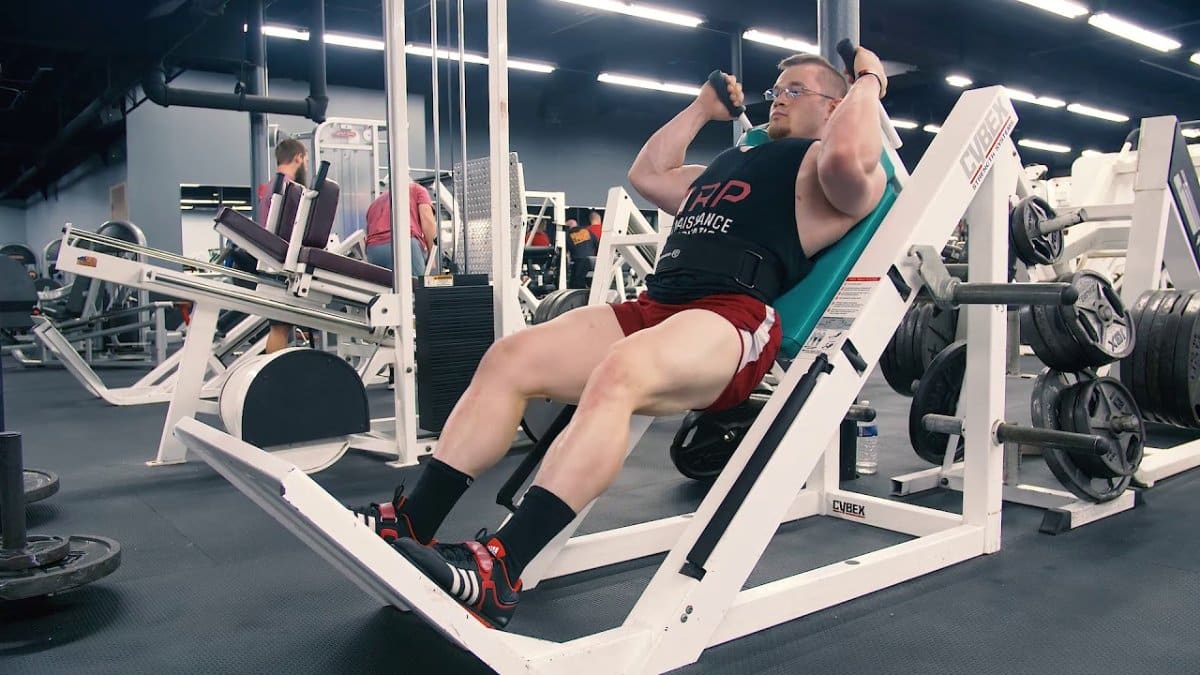Are you looking to tone and strengthen your glutes? Have you heard about hack squats and wonder if they are effective for glute development? Well, you’re in the right place because we’re going to dive into this topic and give you the answer you’ve been looking for!
Hack squats are a popular exercise that targets multiple muscles in your lower body, including the glutes. By placing the weight on your shoulders and positioning your feet behind you on a platform, you can effectively engage your glute muscles. This movement allows you to go deeper into the squat, increasing the activation of your glutes.
In our upcoming article, we’ll explore the specific mechanics of hack squats and their impact on glute development. We’ll also discuss how to properly perform hack squats to maximize results and avoid injury. So, if you’re ready to learn all about hack squats and how they can benefit your glutes, stay tuned for our detailed article!

What are Hack Squats?
Hack squats, also known as reverse squats, are a versatile lower body exercise that primarily targets the quadriceps, hamstrings, and glutes. This exercise is performed using a specialized hack squat machine, which features a foot platform and a backrest for support. Unlike traditional squats, hack squats place a greater emphasis on the glute muscles, making them an excellent choice for targeting and strengthening this specific muscle group.
Benefits of Hack Squats
Hack squats offer a range of benefits, making them a popular choice for those looking to develop their glutes. Here are a few key advantages:
- Glute Activation: Hack squats specifically target the glute muscles, helping to increase their strength, size, and definition.
- Quadriceps and Hamstrings Activation: Along with targeting the glutes, hack squats also engage the quadriceps and hamstrings, leading to overall lower body strength and development.
- Joint-Friendly: The hack squat machine provides support for your body, reducing the strain on your knees and lower back, making it a safer option compared to exercises like barbell squats.
- Variety and Versatility: Hack squats can be performed in various ways, allowing for different foot placements, stance widths, and weight options, making it adaptable to different fitness levels and goals.
Common Mistakes to Avoid
To make the most out of your hack squat workouts and avoid potential injuries, it’s essential to be mindful of these common mistakes:
- Incorrect Form: Ensure your feet are positioned shoulder-width apart and your knees are tracking in line with your toes throughout the movement. Avoid rounding your back or locking your knees.
- Using Excessive Weight: It’s crucial to start with a weight that allows you to maintain proper form. Gradually increase the weight as your strength improves, but avoid straining yourself with excessive weight that compromises your technique.
- Neglecting Full Range of Motion: Make sure to go through a full range of motion by lowering yourself until your thighs are parallel to the ground or slightly below. This will ensure optimal activation of the glutes and other lower body muscles.
- Lack of Warm-up and Stretching: Prior to performing hack squats, warm up your muscles with a few dynamic exercises and stretch your glutes and lower body to prevent any potential injuries.
Understanding Glute Development
Before we delve deeper into the science behind hack squats for glute development, it’s essential to have a basic understanding of the anatomy of the glute muscles, their importance, and the factors that influence their development.
Anatomy of the Glutes
The gluteal muscles, commonly referred to as the glutes, consist of three main muscle groups: the gluteus maximus, gluteus medius, and gluteus minimus. The gluteus maximus is the largest and outermost muscle, responsible for hip extension, hip external rotation, and thigh abduction. The gluteus medius and minimus are located on the side of the hip, playing a role in hip stabilization and hip abduction.
Importance of Glute Strength
Strong glute muscles are not only aesthetically pleasing but also vital for functional movement and overall lower body strength. The glutes play a significant role in activities such as standing, walking, running, and jumping. Additionally, well-developed glutes can help alleviate lower back pain, improve posture, and enhance athletic performance.
Factors Affecting Glute Development
Several factors can influence the development of the glutes, including genetics, diet, exercise selection, and training intensity. While genetics play a role in determining the shape of your glutes, proper nutrition and consistent training can help maximize their potential.

The Science Behind Hack Squats for Glutes
Now let’s delve into the scientific aspects of hack squats and how they effectively target the glute muscles.
Muscles Targeted During Hack Squats
Hack squats primarily target the glutes, quadriceps, and hamstrings. The gluteus maximus is particularly activated during the upward or concentric phase of the movement, where your body is pushing against the resistance. The quadriceps and hamstrings also play a significant role in stabilizing the movement and contributing to lower body strength.
Activation of the Glutes
Research suggests that hack squats can be highly effective in activating the glute muscles. A study published in the Journal of Sports Science and Medicine found that hack squats generated high levels of electromyography (EMG) activity in the gluteus maximus, comparable to other popular glute exercises such as hip thrusts and squats.
Comparing Hack Squats to Other Exercises
While hack squats are great for glute development, it’s important to note that no single exercise can fully isolate the glutes. Squats, lunges, hip thrusts, and deadlifts are also effective compound exercises that engage multiple lower body muscles, including the glutes. Incorporating a combination of these exercises into your training routine can yield optimal results in glute development.
Effectiveness of Hack Squats for Glute Development
To truly understand the effectiveness of hack squats for glute development, it’s essential to examine scientific studies, opinions from fitness experts, and real-life testimonials.
Studies and Research on Hack Squats
Several studies have examined the effectiveness of hack squats in activating the glute muscles. A study published in the Journal of Strength and Conditioning Research found that hack squats produced higher gluteus maximus activation compared to barbell squats. Additionally, the eccentric (lowering) phase of the hack squat was found to elicit higher glute activation compared to the concentric (upward) phase.
Opinions of Fitness Experts
Many fitness experts believe that hack squats are an excellent exercise for targeting the glutes. Certified personal trainers and strength coaches often include hack squats in glute-focused workouts due to their ability to isolate and strengthen the glute muscles. However, they also recommend incorporating a variety of exercises to ensure overall lower body development.
Real-life Testimonials
There are countless individuals who have experienced significant glute development from incorporating hack squats into their fitness routines. These real-life testimonials showcase the effectiveness of hack squats in sculpting and strengthening the glute muscles. However, it’s important to remember that individual results may vary based on factors such as genetics, training intensity, and consistency.

Incorporating Hack Squats Into Your Glute Workout
If you’re ready to incorporate hack squats into your glute workout routine, here are some important considerations to keep in mind:
Proper Form and Technique
Maintaining proper form and technique is crucial for maximizing the effectiveness of hack squats and minimizing the risk of injury. As mentioned earlier, ensure your feet are placed shoulder-width apart, your knees are tracking in line with your toes, and you maintain a neutral spine throughout the movement.
Variations of Hack Squats
Hack squats can be performed in various ways to target different areas of the glutes. Experiment with different foot placements, such as narrow stance, wide stance, or toes pointed outward, to engage the glute muscles from different angles. You can also vary the weight and number of repetitions to challenge your muscles and promote growth.
Combining Hack Squats with Other Exercises
To maximize glute development, it’s beneficial to incorporate hack squats into a comprehensive lower body workout routine. Combine hack squats with exercises such as lunges, deadlifts, hip thrusts, and step-ups to ensure overall lower body strength and development.
Tips for Maximizing Glute Activation in Hack Squats
To further enhance glute activation during hack squats, consider implementing the following tips:
Utilizing Mind-Muscle Connection
Focus on contracting your glute muscles throughout the entire movement. Visualize your glutes working and actively engage them to maximize their involvement in the exercise.
Adjusting Foot Placement and Stance
Experiment with different foot placements and stances to target specific areas of the glutes. For example, a wider stance may emphasize the gluteus maximus, while a narrower stance could engage the gluteus medius to a greater extent.
Applying Progressive Overload
Gradually increase the weight and intensity of your hack squat workouts to continually challenge your glute muscles. This progressive overload stimulates muscle growth and strength gains over time.

Safety Considerations and Precautions
It is important to prioritize safety in any exercise routine. Here are some safety considerations and precautions to keep in mind when performing hack squats:
Importance of Warming Up
Before starting hack squats or any other exercise, warm up your muscles with dynamic movements such as leg swings, hip circles, or light cardio. Warming up prepares your body for exercise and helps prevent injuries.
Stretches for the Glutes
After your workout, include stretches that target the glute muscles. Some effective stretches include the seated figure-four stretch, lying glute stretch, and pigeon pose.
Avoiding Excessive Weight or Intensity
While it’s necessary to challenge yourself during workouts, using excessively heavy weights or pushing yourself beyond your limits can increase the risk of injury. Listen to your body and gradually increase the weight and intensity of your workouts over time.
Common Myths and FAQs about Hack Squats and Glute Development
Let’s address a few common myths and frequently asked questions about hack squats and glute development:
Do Hack Squats Make Your Glutes Bulky?
No, hack squats alone will not make your glutes bulky unless you specifically train for hypertrophy (muscle growth) and consume a surplus of calories. Developing bulky glutes requires a combination of proper training, nutrition, and genetic factors.
Can Hack Squats Replace Traditional Squats?
Hack squats can be a great addition to your lower body workout routine, but they should not completely replace traditional squats. Traditional squats engage a greater range of motion and also target other muscle groups such as the core and lower back.
How Often Should You Do Hack Squats?
The frequency of hack squat workouts will depend on your individual goals, fitness level, and recovery capacity. Generally, incorporating hack squats into your lower body routine two to three times a week can lead to positive results in glute development.

Conclusion
In conclusion, hack squats are indeed effective for glute development. Their ability to specifically target the glute muscles, along with their versatility and joint-friendly nature, make them an excellent choice for strengthening and sculpting the glutes.
By understanding proper form, incorporating progressive overload, and combining hack squats with other exercises, you can maximize glute activation and achieve your desired results. So, why not give hack squats a try and take your glute development to the next level? Happy squatting!




